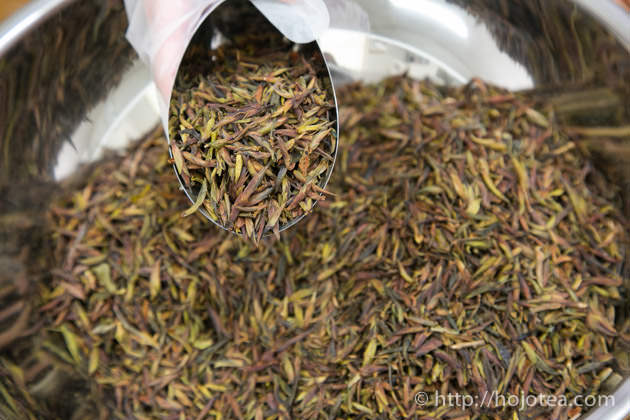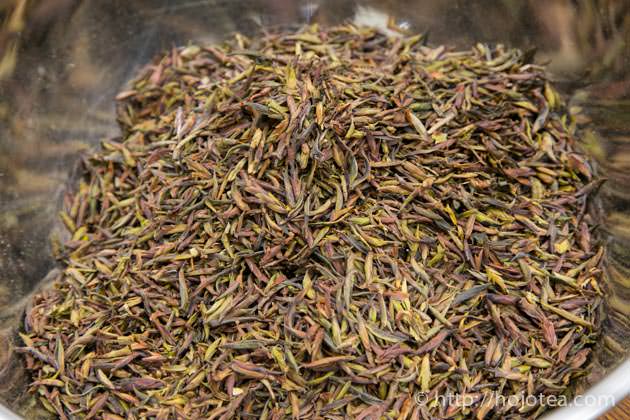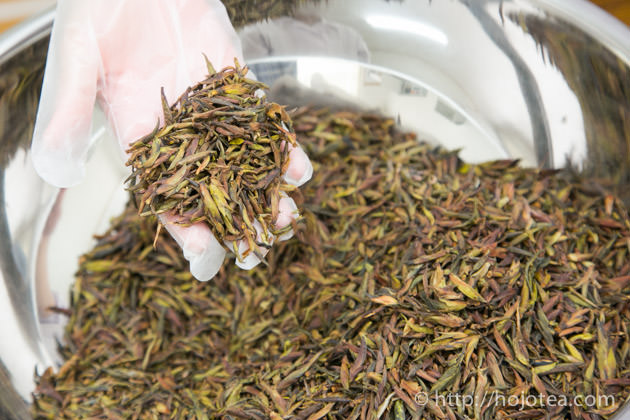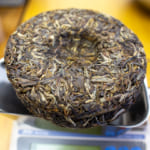- HOME >
- New Arrival at HOJO Online Shop
Wild Spring Bud harvested from the wild tea tree at Da Xue Shan
- [2014.08.22] Posted By Akira Hojo
We just released Wild Spring Bud raw pu-erh tea mao-cha; it is the loose tea buds harvested from the wild tree at Da Xue Shan area. We had ever sold this tea last year. In last year we only introduced the mao-cha of wild spring bud only for the customer who made a reservation in advance and the balance was compressed into 200g cake.
The native tea collected from the mountain
The Wild Spring Bud is literally the wild tea that is naturally grown in the native forest. It is not referring to the tea tree that age is like 500 years old or 1000 years old. The wild tea means native plant in the forest.
Our wild spring bud is harvested from Da Xue Shan area in Lincang city. The tea processed from the first flush of young buds plucked in March is named as Wild Spring Bud and the tea processed from 1 bud and 2 leaves is named as Da Xue Shan Wild Tea.
Da Xue Shan, Wu Laing Shan and Ai Lao Shan, the major production area of Wild Tea
The wild tea exists not only in Da Xue Shan but also in Wu Liang Shan and Ai Lao Shan, and some are found at the border to Myanmar. As far as I have experienced, generally the wild tea from Wu Liang Shan gives lighter taste in terms of body and after taste and the one from Ai Lao Shan gives the least after taste with slight bitterness. As for the wild tea from Da Xue Shan, it gives strongest after taste and body in general. However, some of the Da Xue Shan wild tea gives bitter taste too. We selected the tea that gives no bitterness.
Camellia Taliensis
In fact, there are many types of wild tea available in Yunnan. The wild tea is not only the tea made from Camellia sinensis but also it consists of a few other sub-species of Camellia sinensis. For example, the Da Xue Shan Wild Tea and Wild Spring Bud are made from the Camellia taliensis, which is said to be the closest species of Camellia sinensis. The Camellia taliensis is often recognized as the wild tea, and also it is found in the tea garden especially near the Myanmar border. I also saw a number of Camellia taliensis planted in the tea garden when I visited Myanmar before. The tea made from Camellia taliensis was traditionally drunk by the minority people.

I saw the tree of Camellia taliensis when I visited the village in Lincang. These tea trees already involve human care and it should not be called as the wild tea.
Clear fruity flavor
The flavour of the Wild Spring Bud is very sweet and clear that reminds us of grapes or green apple. The body of this tea is moderate since it only consists of the spring buds. Instead, it gives a very clear and transparency flavour with lingering sweetish taste on our palate for a long time after drinking.
Related Articles
How to get the latest update on HOJO?
1. Follow Twitter, 2. Click "Like" on Facebook, and 3. Subscribe in newsletter. You can have the latest tea news from HOJO.
 Subscribe the Newsletter to enjoy the privileges
Subscribe the Newsletter to enjoy the privileges- You may receive a free sample upon purchase, or you may have the priority to purchase special products. So please remember to subscribe our newsletter as well as the social network.
- New Arrival of Akitsu Mumyoi and Nosaka Rough Clay Teapot
- A wide selection of teaware by Watanabe Tozo, a Sado-based artist of Mumyoi-yaki, has just arrived. This time, …
- Mang Fei Ripe Pu-erh Tea 2023 – Small-Batch Production from a Renowned Region
- Mang Fei Ripe Pu-erh Tea 2023 is now available. This is one of the highest-quality ripe pu-erh teas among our …
NEW ARTICLES
 Development of Firewood Roasted Hojicha Using Naturally Grown Tea from Yunnan
Development of Firewood Roasted Hojicha Using Naturally Grown Tea from Yunnan- We are currently staying in Yunnan Province for tea production. As the season nears its end, tea trees with pa …
 Exploring the Food Culture of Yunnan: Where Minority and Sichuan Cuisines Meet
Exploring the Food Culture of Yunnan: Where Minority and Sichuan Cuisines Meet- We are currently staying long-term in Yunnan Province for spring tea production. On rainy days or when there i …
 New Arrival of Akitsu Mumyoi and Nosaka Rough Clay Teapot
New Arrival of Akitsu Mumyoi and Nosaka Rough Clay Teapot- A wide selection of teaware by Watanabe Tozo, a Sado-based artist of Mumyoi-yaki, has just arrived. This time, …
 Managing Yunnan White Tea — Insights from the Field
Managing Yunnan White Tea — Insights from the Field- Since March 25, we have been in Yunnan Province, fully engaged in the production of white tea. In this column, …
 Mang Fei Ripe Pu-erh Tea 2023 – Small-Batch Production from a Renowned Region
Mang Fei Ripe Pu-erh Tea 2023 – Small-Batch Production from a Renowned Region- Mang Fei Ripe Pu-erh Tea 2023 is now available. This is one of the highest-quality ripe pu-erh teas among our …
 Yunnan Tea Trends 2025: Insights from the Fields
Yunnan Tea Trends 2025: Insights from the Fields- Since March 25, we have been in Yunnan Province. We will stay here until May to conduct tea production, packin …
 Why Do Some Teas Taste Astringent? Exploring the Causes and Mechanisms of Astringency
Why Do Some Teas Taste Astringent? Exploring the Causes and Mechanisms of Astringency- Tea can range from having no noticeable astringency to possessing a very strong one. What causes this astringe …
 The Impact of Heat Sources on Tea Flavor
The Impact of Heat Sources on Tea Flavor- It is widely recognized that the material of a kettle plays an important role in shaping the taste of water fo …
 New Release of Tang Li Shan Ripe Pu-erh Tea 2023
New Release of Tang Li Shan Ripe Pu-erh Tea 2023- We have released the 2023 edition of Tang Li Shan Ripe Pu-erh Tea. Tang Li Shan refers to a mountain located o …
 The New Release of Dong Shan Raw Pu-erh Tea 2023 and Jasmine Silver Needle
The New Release of Dong Shan Raw Pu-erh Tea 2023 and Jasmine Silver Needle- We have released Dong Shan Raw Pu-erh Tea 2023 and Jasmine Silver Needle. Dong Shan Raw Pu-erh Tea 2023 We hav …
Category
- New Arrival at HOJO Online Shop
- Featured Articles
- Newsletter
- Types of Tea
- Origin of Tea
- Teapot and Tea Equipment
- Tea Column
- How to enjoy tea
- Tea Processing
- How to choose quality tea
- Tea constituents and functional effect
- Safety of Tea
- Foods
- Tea Business Operation
- Hobby and Outdoor Activity
- Ranking of Tea
- Video
- FAQ
- Media Release
Profile

- AKIRA HOJO
- I invite you to experience my tea selections.I was born in Nagano, Japan. In university, I studied agricultural chemistry, and I have the master degree in food science. I worked in Japanese food industry for 10 years. I involved in R&D, QC and QA. As a factory manager, I implemented ISO9000 series and managed the factory.
- The Art of Tea Magazine
- We posted the article on “The Art of Tea Magazine No.9, the magazine is published in Taiwan. We featured …
- New Straits Times
- The Malaysian National Newspaper, New Straits Times featured HOJO Tea on 17-Oct-2007.
Shop Info

Address:Lot No. T-215, 3rd Floor, The Gardens Mall, Mid Valley City, Lingkaran Syed Putra, 59200 Kuala Lumpur
Tel: +603-2287-4537
Business Hour: 10am to 10pm



















